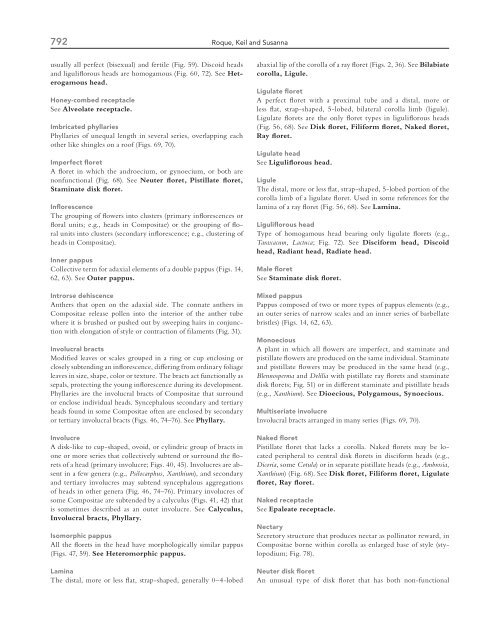Illustrated glossary of Compositae
Illustrated glossary of Compositae
Illustrated glossary of Compositae
You also want an ePaper? Increase the reach of your titles
YUMPU automatically turns print PDFs into web optimized ePapers that Google loves.
792<br />
usually all perfect (bisexual) and fertile (Fig. 59). Discoid heads<br />
and ligulifl orous heads are homogamous (Fig. 60, 72). See Heter<br />
ogamous head.<br />
Honey-combed receptacle<br />
See Alveolate receptacle.<br />
Imbricated phyllaries<br />
Phyllaries <strong>of</strong> unequal length in several series, overlapping each<br />
other like shingles on a ro<strong>of</strong> (Figs. 69, 70).<br />
Imperfect fl oret<br />
A fl oret in which the androecium, or gynoecium, or both are<br />
nonfunctional (Fig. 68). See Neuter fl oret, Pistillate fl oret,<br />
Staminate disk fl oret.<br />
Infl orescence<br />
The grouping <strong>of</strong> fl owers into clusters (primary infl orescences or<br />
fl oral units; e.g., heads in <strong>Compositae</strong>) or the grouping <strong>of</strong> fl oral<br />
units into clusters (secondary infl orescence; e.g., clustering <strong>of</strong><br />
heads in <strong>Compositae</strong>).<br />
Inner pappus<br />
Collective term for adaxial elements <strong>of</strong> a double pappus (Figs. 14,<br />
62, 63). See Outer pappus.<br />
Introrse dehiscence<br />
Anthers that open on the adaxial side. The connate anthers in<br />
<strong>Compositae</strong> release pollen into the interior <strong>of</strong> the anther tube<br />
where it is brushed or pushed out by sweeping hairs in conjunction<br />
with elongation <strong>of</strong> style or contraction <strong>of</strong> fi laments (Fig. 31).<br />
Involucral bracts<br />
Modifi ed leaves or scales grouped in a ring or cup enclosing or<br />
closely subtending an infl orescence, diff ering from ordinary foliage<br />
leaves in size, shape, color or texture. The bracts act functionally as<br />
sepals, protecting the young infl orescence during its development.<br />
Phyllaries are the involucral bracts <strong>of</strong> <strong>Compositae</strong> that surround<br />
or enclose individual heads. Syncephalous secondary and tertiary<br />
heads found in some <strong>Compositae</strong> <strong>of</strong>ten are enclosed by secondary<br />
or tertiary involucral bracts (Figs. 46, 74–76). See Phyllary.<br />
Involucre<br />
A disk-like to cup-shaped, ovoid, or cylindric group <strong>of</strong> bracts in<br />
one or more series that collectively subtend or surround the fl orets<br />
<strong>of</strong> a head (primary involucre; Figs. 40, 45). Involucres are absent<br />
in a few genera (e.g., Psilocarphus, Xanthium), and secondary<br />
and tertiary involucres may subtend syncephalous aggregations<br />
<strong>of</strong> heads in other genera (Fig. 46, 74–76). Primary involucres <strong>of</strong><br />
some <strong>Compositae</strong> are subtended by a calyculus (Figs. 41, 42) that<br />
is sometimes described as an outer involucre. See Calyculus,<br />
Involucral bracts, Phyllary.<br />
Isomorphic pappus<br />
All the fl orets in the head have morphologically similar pappus<br />
(Figs. 47, 59). See Heteromorphic pappus.<br />
Lamina<br />
The distal, more or less fl at, strap-shaped, generally 0–4-lobed<br />
Roque, Keil and Susanna<br />
abaxial lip <strong>of</strong> the corolla <strong>of</strong> a ray fl oret (Figs. 2, 36). See Bilabiate<br />
corolla, Ligule.<br />
Ligulate fl oret<br />
A perfect fl oret with a proximal tube and a distal, more or<br />
less fl at, strap-shaped, 5-lobed, bilateral corolla limb (ligule).<br />
Ligulate fl orets are the only fl oret types in ligulifl orous heads<br />
(Fig. 56, 68). See Disk fl oret, Filiform fl oret, Naked fl oret,<br />
Ray fl oret.<br />
Ligulate head<br />
See Ligulifl orous head.<br />
Ligule<br />
The distal, more or less fl at, strap-shaped, 5-lobed portion <strong>of</strong> the<br />
corolla limb <strong>of</strong> a ligulate fl oret. Used in some references for the<br />
lamina <strong>of</strong> a ray fl oret (Fig. 56, 68). See Lamina.<br />
Ligulifl orous head<br />
Type <strong>of</strong> homogamous head bearing only ligulate fl orets (e.g.,<br />
Taraxacum, Lactuca ; Fig. 72). See Disciform head, Discoid<br />
head, Radiant head, Radiate head.<br />
Male fl oret<br />
See Staminate disk fl oret.<br />
Mixed pappus<br />
Pappus composed <strong>of</strong> two or more types <strong>of</strong> pappus elements (e.g.,<br />
an outer series <strong>of</strong> narrow scales and an inner series <strong>of</strong> barbellate<br />
bristles) (Figs. 14, 62, 63).<br />
Monoecious<br />
A plant in which all fl owers are imperfect, and staminate and<br />
pistillate fl owers are produced on the same individual. Staminate<br />
and pistillate fl owers may be produced in the same head (e.g.,<br />
Blennosperma and Delilia with pistillate ray fl orets and staminate<br />
disk fl orets; Fig. 51) or in diff erent staminate and pistillate heads<br />
(e.g., Xanthium). See Dioecious, Polygamous, Synoecious.<br />
Multiseriate involucre<br />
Involucral bracts arranged in many series (Figs. 69, 70).<br />
Naked fl oret<br />
Pistillate fl oret that lacks a corolla. Naked fl orets may be located<br />
peripheral to central disk fl orets in disciform heads (e.g.,<br />
Dicoria, some Cotula) or in separate pistillate heads (e.g., Ambrosia,<br />
Xanthium) (Fig. 68). See Disk fl oret, Filiform fl oret, Ligulate<br />
fl oret, Ray fl oret.<br />
Naked receptacle<br />
See Epaleate receptacle.<br />
Nectary<br />
Secretory structure that produces nectar as pollinator reward, in<br />
<strong>Compositae</strong> borne within corolla as enlarged base <strong>of</strong> style (stylopodium;<br />
Fig. 78).<br />
Neuter disk fl oret<br />
An unusual type <strong>of</strong> disk fl oret that has both non-functional


